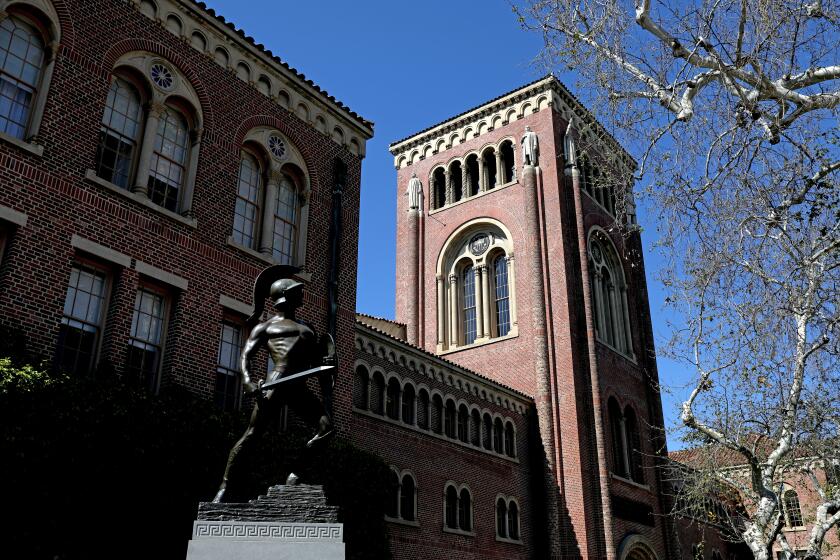Why are more students chronically absent in California, U.S.? Study examines troubling trend

- Share via
Since the pandemic, the number of students across the country who are chronically absent — meaning they missed at least 10% of the school year — has nearly doubled to 13.6 million, according to estimates in a new study.
About 1.8 million of these students were from California, which saw its chronic absenteeism explode from about 12% in the school year before the COVID-19 pandemic to 30% in 2021-22, according to data compiled by Stanford University education professor Thomas S. Dee in partnership with the Associated Press. EdSource, a nonprofit newsroom that covers California education, analyzed California data.
California had among the highest increases in chronic absenteeism in the country. The percentages translate to about 1 million additional chronically absent California children when compared with the year before the pandemic. For students on a typical 180-day school calendar, missing 10% of the school year represents nearly one month — missed learning time that compounds the challenge of helping students recover academically and emotionally from the pandemic.
Data are not yet available for the 2022-23 school year, although limited information from some California school districts and two other states suggest attendance may not be greatly improving, Dee said.
The findings “should really be a kind of clarion call to learn more about exactly what is explaining this incredible growth,” he said.
Complex issues
Issues that contribute to chronic absenteeism can be multilayered.
Juan Ballina, 17, has epilepsy; a trained staff member must be nearby to administer medication in case of a seizure. But during the pandemic, many school nurses left their jobs, exacerbating shortages.
Last year, Juan’s nurse was on medical leave. His school couldn’t find a substitute. He missed more than 90 days at his Chula Vista high school.
“I was lonely,” Juan said. “I missed my friends.”
This year his school has a nurse and Juan is back in class, but the effect of his absences persists, his mother, Carmen Ballina, said: “He used to read a lot more. I don’t think he’s motivated anymore.”
When students were in remote learning, engagement from home was a major problem. Many students had computer or internet access problems or simply weren’t logging on often enough and for sustained periods. Distractions at home and family hardships made things worse.
Schools have used COVID relief and recovery funds to provide academic and mental health support, but these services work best for students who are in school. And as schools struggle to get students to class, the funding for such extra support is rapidly running out.
California’s ‘missing’ students may have moved away, be home-schooling without notifying the state, or simply be out of school.
Compared with before the pandemic, absences worsened in every state with available data.
At the state level, Dee did not find a strong correlation between rates of absence and COVID-19 infection rates or COVID-19 safety policies, such as requiring or banning the use of masks. However, the lack of detail in the state-level data could have obscured measurable effects at the local level.
Dee concluded that while sickness may have contributed to the surge in chronic absenteeism, “it’s not really wholly explaining it … so the evidence is pointing to other substantive and enduring factors.”
Dee and other experts attribute the absences to factors including the emotional and financial fallout of pandemic-related deaths, access to school transportation, increased anxieties around the safety of attending school in person, and declines in youth mental health and academic engagement.
“The pandemic’s over, but if people lost family members, that matters,” said Hedy Chang, executive director of a chronic absenteeism initiative called Attendance Works. “That’s a lasting impact on a whole set of things, both emotional and economic.”
LAUSD steps up efforts
The Los Angeles Unified School District had a 40% chronic absentee rate in the 2021-22 school year — about 10 percentage points higher than the state’s. Alarmed by the numbers, officials accelerated an outreach campaign targeting students and their families — including those struggling with homelessness.
Although the data have not been officially reported by the state, Supt. Alberto Carvalho said internal record keeping shows a 10-percentage-point drop in chronic absenteeism during the 2022-23 school year, which would translate to a 30% chronic absenteeism rate.
Although Carvalho characterized this drop as an signature achievement, the rate remains higher than the 20% pre-pandemic level, a number that was already considered high.
Nearly half of L.A. students were chronically absent last year. Educators say they must bring children back to class.
As part of the district’s iAttend program, administrators, principals, attendance counselors and other staff knocked on 9,000 doors last school year to encourage families of chronically absent or unenrolled students to return to class. The next event is planned for Friday.
Elmer Roldan, executive director of Communities in Schools of Los Angeles, said the effects of online learning linger: School relationships have frayed, and after months at home, many parents and students don’t see the point of regular attendance.
“For almost two years, we told families that school can look different and that schoolwork could be accomplished in times outside of the traditional 8-to-3 day. Families got used to that,” he said.
The district’s grading policies also have changed, based on compassion during the pandemic and changes in academic philosophy. The district has entirely disconnected grades from attendance, turning in assignments on time and classroom behavior.
In promoting good attendance, the school system stresses the positives. Officials have ongoing supports for students, such as on-demand online tutoring and extra school days to catch up with assignments. But such assistance works best when students are in school.
Another issue confronting L.A. Unified and other state school systems is the financial burden of low attendance. California funds schools largely based on attendance rather than enrollment. Absent students ultimately mean less money to educate all and to pay for services and staff.
Rural district challenges
Many of California’s districts in small towns and rural regions faced high chronic absenteeism rates long before the pandemic and, according to an EdSource analysis, rural districts as a group have seen the sharpest increases since then.
Renee Slater’s daughter is a straight-A middle-school student and student council member in the Rio Bravo-Greeley Union School District in the Bakersfield area. Yet, she missed 20 days this past school year.
The eighth-grader had good attendance before the pandemic, but that changed when she began insisting on staying home more often than she ever had, her mother said.
“She’d just be like: ‘I don’t feel good today — I’m just gonna stay home,’” Slater said. “She doesn’t dislike school; it was just a change in mind-set. Like, you know, I can make it up.”
Slater, a district teacher, worries her daughter’s learning is suffering.
Their district’s chronic absenteeism rates rose to 21% during the 2021-22 school year, up from 8% in 2018-19.
Chang, of Attendance Works, said increased communication, including postcards and text messages that help connect to students and families, could help improve rates.
At Lodi Unified, a 28,000-student urban district in Central California, families will begin receiving a weekly letter with updates on school activities. The “Sunday night letters,” as they’re being referred to, were sparked in part by a tripling of chronic absenteeism rates to 39.2% in 2021-22.
Knocking on absent students’ doors to do wellness checks isn’t feasible in some rural districts, where students can live miles apart, educators said.
In Modoc, the state’s most northeastern county, distance leads to absences, Supt. Tom O’Malley said.
“If you need any kind of advanced services, if you’re a child who’s got some kind of a medical issue, you’re going to be gone a lot,” said O’Malley, who grew up in the area.
The nearly 900-student district experienced an increase of 15 percentage points in chronic absenteeism between the 2018-19 and 2021-22 school years.
“Our kids miss a lot of school, but you kind of have to,” he said. “There’s no way around it.”
Signs of continuing high absences
In Dee’s study, two states — Massachusetts and Connecticut — are reporting continued high absentee rates for the 2022-23 school year, a trend that also may be surfacing in California districts.
School Innovations and Achievement, a national attendance consulting firm that works with 29 of the California’s nearly 1,000 districts, estimated that the rate of chronic absenteeism could drop from 32.7% in 2021-22 to 30.5% in 2022-23 in these districts. The firm declined to share the names of districts, but said they reflect California’s diverse geographic regions, district sizes and student demographics.
“A lot of the feelings of safety, security and connectedness were broken and disrupted due to the pandemic, and so [students] are just now starting to build school-going habits and reestablishing connections at schools,” said Erica Peterson, the firm’s director of education and engagement.
This article was reported and written in partnership with EdSource, a nonprofit newsroom that covers education in California, and the Associated Press. Rosales writes for EdSource, Toness writes for the Associated Press, and Blume is a Times staff writer. Mallika Seshadri and Daniel J. Willis of EdSource and Cara Nixon, an EdSource intern, contributed to this report.
More to Read
Sign up for Essential California
The most important California stories and recommendations in your inbox every morning.
You may occasionally receive promotional content from the Los Angeles Times.












